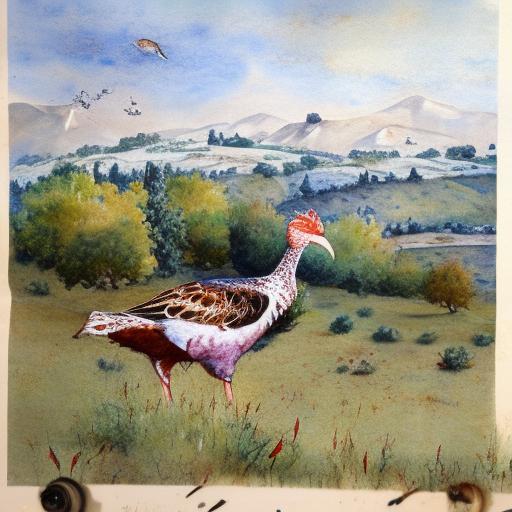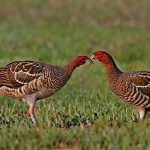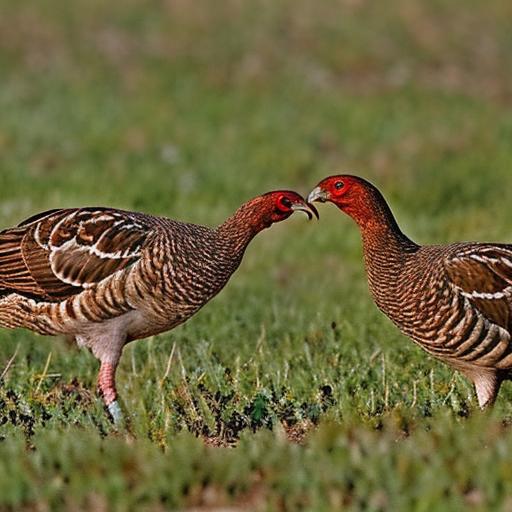The turkey breeding season is a crucial time for turkey farmers as it determines the success of their operations for the year. The breeding season typically occurs in the spring, when the days are longer and the weather is warmer. During this time, male turkeys, known as toms, become more active and display mating behaviors such as strutting, gobbling, and puffing out their feathers to attract female turkeys, known as hens. The hens also become more receptive to mating during this time, signaling their readiness by making specific calls and assuming a receptive posture.
The breeding season is essential for the continuation of the turkey population and the production of turkey meat and eggs. It is during this time that fertilization occurs, leading to the development of turkey eggs that will hatch into poults. Understanding the turkey breeding season is crucial for turkey farmers to ensure that they can maximize their production and maintain a healthy and sustainable turkey population.
The turkey breeding season is a natural process that is influenced by various factors such as daylight length, temperature, and genetics. By understanding these factors, turkey farmers can effectively manage the breeding season to optimize their production and ensure the health and well-being of their turkeys.
Key Takeaways
- Turkey breeding season typically occurs in the spring and early summer, when longer daylight hours and warmer temperatures stimulate mating behavior.
- Factors such as nutrition, genetics, and environmental conditions can affect the length of the turkey breeding season, impacting the number of viable eggs and overall productivity.
- The duration of the turkey breeding season is crucial for maximizing egg production and ensuring a consistent supply of turkey poults for the market.
- Techniques such as artificial lighting and hormone manipulation can be used to extend the turkey breeding season, allowing for increased production and profitability.
- Proper management practices, including monitoring flock health, providing optimal nutrition, and controlling environmental stressors, are essential for a successful turkey breeding season.
- Challenges such as disease outbreaks, reproductive issues, and unpredictable weather can impact the success of the turkey breeding season, requiring proactive management and mitigation strategies.
- Maximizing the turkey breeding season is essential for meeting market demand and optimizing profitability in the turkey production industry.
Factors Affecting the Length of Turkey Breeding Season
The length of the turkey breeding season is influenced by several factors, with daylight length being one of the most significant. As the days become longer in the spring, it triggers hormonal changes in both male and female turkeys, leading to increased mating behaviors and receptivity. The longer daylight hours signal toms that it’s time to start displaying mating behaviors, while hens become more receptive to mating as a result of these hormonal changes.
Temperature also plays a role in the length of the breeding season, as warmer weather can stimulate increased activity and mating behaviors in turkeys. Warmer temperatures can also lead to better egg production and fertility, which is essential for a successful breeding season. Additionally, genetics can influence the length of the breeding season, as certain turkey breeds may be more predisposed to longer or shorter breeding seasons based on their genetic makeup.
Other factors such as nutrition, health, and stress levels can also impact the length of the breeding season. Turkeys that are well-nourished and in good health are more likely to have a longer and more successful breeding season compared to those that are malnourished or experiencing health issues. Minimizing stress factors such as overcrowding, predator threats, or sudden changes in environment can also help extend the breeding season and improve overall reproductive success.
The Importance of Turkey Breeding Season Duration
The duration of the turkey breeding season is crucial for turkey farmers as it directly impacts their production and profitability. A longer breeding season allows for more opportunities for mating and fertilization, leading to increased egg production and a higher number of viable poults. This is essential for maintaining a healthy and sustainable turkey population and ensuring a consistent supply of turkey meat and eggs for consumers.
A longer breeding season also provides turkey farmers with more flexibility in managing their production schedules. With more opportunities for mating and egg production, farmers can stagger their hatching times to ensure a continuous supply of poults throughout the year. This can help meet market demands and maintain a steady income stream for the farm.
Furthermore, a longer breeding season can contribute to genetic diversity within the turkey population, which is essential for maintaining healthy and robust turkeys. Genetic diversity helps reduce the risk of inbreeding and genetic abnormalities, leading to stronger and more resilient turkeys that are better equipped to thrive in various environmental conditions.
Extending the Turkey Breeding Season
There are several strategies that turkey farmers can employ to extend the breeding season and maximize reproductive success. One effective method is to provide artificial lighting in turkey housing facilities to simulate longer daylight hours. By extending the hours of light exposure, farmers can trick turkeys into thinking that the days are longer, which can stimulate mating behaviors and increase egg production.
Another strategy is to carefully manage the nutrition of the turkeys during the breeding season. Providing a well-balanced diet that meets the nutritional needs of the turkeys can help support reproductive health and increase fertility. Ensuring that turkeys have access to high-quality feed with adequate levels of protein, vitamins, and minerals can contribute to a longer and more successful breeding season.
Additionally, minimizing stress factors such as overcrowding, predator threats, or sudden changes in environment can help extend the breeding season. Creating a calm and stable environment for the turkeys can reduce stress levels and promote reproductive health, leading to increased mating behaviors and better egg production.
Managing the Turkey Breeding Season
Managing the turkey breeding season requires careful planning and attention to detail to ensure optimal reproductive success. One important aspect of managing the breeding season is monitoring the health and behavior of the turkeys. Regular health checks can help identify any potential issues that may impact reproductive health, allowing farmers to take proactive measures to address them.
It’s also essential to provide proper housing and nesting facilities for the turkeys during the breeding season. Creating comfortable and secure nesting areas can encourage hens to lay eggs and increase the chances of successful hatching. Additionally, providing adequate space for mating behaviors and minimizing overcrowding can help reduce stress levels and promote successful reproduction.
Another crucial aspect of managing the breeding season is monitoring egg production and fertility rates. Keeping track of egg production and fertility can help farmers identify any potential issues early on and take corrective actions to improve reproductive success. This may involve adjusting nutrition, lighting schedules, or environmental conditions to support better egg production and fertility.
Challenges of the Turkey Breeding Season

Despite efforts to manage and extend the turkey breeding season, there are several challenges that turkey farmers may face. One common challenge is maintaining optimal environmental conditions during the breeding season. Sudden changes in temperature or weather patterns can impact mating behaviors and egg production, leading to reduced reproductive success.
Another challenge is managing stress factors that can impact reproductive health. Overcrowding, predator threats, or sudden changes in environment can cause stress in turkeys, leading to decreased mating behaviors and fertility rates. Minimizing these stress factors requires careful planning and proactive measures to create a calm and stable environment for the turkeys.
Additionally, genetic factors can also present challenges during the breeding season. Certain turkey breeds may be more predisposed to reproductive issues or have lower fertility rates, requiring farmers to carefully select breeding stock and implement genetic management strategies to improve reproductive success.
Maximizing the Turkey Breeding Season
In conclusion, understanding the turkey breeding season is essential for turkey farmers to maximize their production and maintain a healthy and sustainable turkey population. Factors such as daylight length, temperature, genetics, nutrition, health, and stress levels all play a role in influencing the length of the breeding season. By carefully managing these factors and implementing strategies to extend the breeding season, farmers can increase reproductive success and ensure a continuous supply of turkey meat and eggs for consumers.
Managing the turkey breeding season requires careful planning, monitoring, and proactive measures to support optimal reproductive health. Providing artificial lighting, managing nutrition, minimizing stress factors, monitoring health and behavior, providing proper housing and nesting facilities, and monitoring egg production and fertility rates are all essential aspects of managing the breeding season.
Despite challenges such as maintaining optimal environmental conditions, managing stress factors, and genetic predispositions, turkey farmers can overcome these obstacles by implementing effective management strategies and proactive measures. By doing so, they can maximize their turkey breeding season and ensure a consistent supply of high-quality turkey products for consumers.
If you’re interested in learning more about turkey breeding season and how it impacts poultry farming, you may also want to check out this informative article on the importance of maintaining a clean and comfortable floor in your chicken coop. Proper coop maintenance is crucial for the health and well-being of your birds, especially during breeding season. You can read more about it here.
FAQs
What is the turkey breeding season?
The turkey breeding season refers to the time of year when turkeys engage in mating and reproduction activities.
How long does the turkey breeding season last?
The turkey breeding season typically lasts from early spring to early summer, spanning a period of approximately 2-3 months.
What factors influence the length of the turkey breeding season?
The length of the turkey breeding season can be influenced by factors such as environmental conditions, availability of food and resources, and the overall health and condition of the turkey population.
Why is the turkey breeding season important?
The turkey breeding season is important for the continuation of the species, as it is the time when turkeys mate and produce offspring, ensuring the survival and growth of the population.
What behaviors are associated with the turkey breeding season?
During the breeding season, male turkeys (toms) display mating behaviors such as strutting, gobbling, and displaying their plumage to attract females (hens). Females may also exhibit receptive behaviors to indicate their readiness to mate.
Meet Walter, the feathered-friend fanatic of Florida! Nestled in the sunshine state, Walter struts through life with his feathered companions, clucking his way to happiness. With a coop that’s fancier than a five-star hotel, he’s the Don Juan of the chicken world. When he’s not teaching his hens to do the cha-cha, you’ll find him in a heated debate with his prized rooster, Sir Clucks-a-Lot. Walter’s poultry passion is no yolk; he’s the sunny-side-up guy you never knew you needed in your flock of friends!







